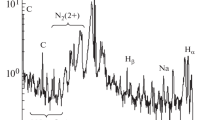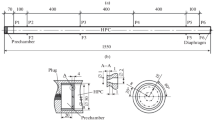Abstract
The results of measuring the radiation characteristics of the shock-heated mixture of CO2–N2 simulating the atmosphere of Mars are presented. Experiments carried out on a modified double-diaphragm shock tube (DDST-M) of the Institute of Mechanics, Moscow State University for two combinations of initial pressures and velocities of the shock wave: 5.4–6.8 km/s at a pressure of 1.0 Torr and 5.3–8.1 km/s at a pressure of 0.3 Torr. Panoramic radiation spectra in the wavelength range of 200 to 850 nm (ultraviolet and visible spectral ranges) and the temporal dependence of the radiation intensity of one of the most intense emission bands were obtained. The measurement data are compared with the experimental data of other authors.






Similar content being viewed by others
REFERENCES
P. Reyner, Galaxies 9 (15) (2021).
D. Bose, J. H. Grinstead, D. W. Bogdanoff, and M. J. Wright, in Proceedings of the 3rd International Workshop on Radiation of High Temperature Gases in Atmospheric Entry (ESA, Heraklion, 2008), No. ESA SP-667.
P. Reyner, Prog. Aerospace Sci. 85, 1 (2016).
S. Gu and H. Olivier, Prog. Aerospace Sci. 113, 100607 (2020).
J. Y. Grinstead, M. J. Wright, D. W. Bogdanoff, and G. A. Allen, J. Thermophys. Heat Transfer 23, 249 (2009).
B. A. Cruden, D. Prabhu, R. Martinez, et al., AIAA Paper No. 2010-4508 (2010).
B. A. Cruden, D. Prabhu, and R. Martinez, J. Spacecr. Rockets 49, 1069 (2012).
A. M. Brandis, C. O. Johnston, B. A. Cruden, et al., AIAA Paper No. 2013-1055 (2013).
A. M. Brandis, C. O. Johnston, B. A. Cruden, et al., J. Quant. Spectrosc. Radiat. Transfer 121, 91 (2013).
V. A. Gorelov, A. Yu. Kireev, and S. V. Shilenkov, J. Appl. Mech. Tech. Phys. 46, 160 (2005).
H. Takayanagi, A. Lemal, S. Nomura, and K. Fujita, J. Thermophys. Heat Transfer 32, 483 (2018).
E. M. Anokhin, T. Yu. Ivanova, N. N. Kudryavtsev, and A. Yu. Starikovskii, High Temp. 45, 733 (2007).
A. S. Dikalyuk, S. T. Surzhikov, P. V. Kozlov, et al., AIAA Paper No. 2012-0795 (2012).
A. S. Dikalyuk, S. T. Surzhikov, P. V. Kozlov, et al., AIAA Paper No. 2013-2505 (2013).
N. G. Bykova, I. E. Zabelinskii, L. B. Ibragimova, P. V. Kozlov, S. V. Stovbun, A. M. Tereza, and O. P. Shatalov, Russ. J. Phys. Chem. B 12, 108 (2018).
V. Yu. Levashov, P. V. Kozlov, N. G. Bykova, and I. E. Zabelinskii, Russ. J. Phys. Chem. B 15, 56 (2021).
S. Surzhikov and P. Kozlov, in Proceedings of the 55th AIAA Aerospace Sci. Meeting, AIAA Sci. Tech. Forum (AIAA, Grapevine, TX, 2017), Vol. 157, p. 1. https://doi.org/10.2514/6.2017-0157
S. D. McGuirea, A. C. Tibère-Inglessea, P. B. Mariotto, et al., J. Quant. Spectrosc. Radiat. Transfer 245, 106855 (2020).
M. A. Ridenti and J. Amorim, Plasma Chem. Plasma Process. 38, 311 (2018).
E. Carbone, F. D’Isa, A. Hecimovic, and U. Fantz, Plasma Sources Sci. Technol. 29, 055003 (2020).
G. N. Zalogin, P. V. Kozlov, L. A. Kuznetsova, S. A. Losev, V. N. Makarov, Yu. V. Romanenko, and S. T. Surzhikov, Tech. Phys. 46, 654 (2001).
Funding
This study was supported by the Russian Foundation for Basic Research, grant no. 20-08-00343, and as part of a state assignment of the Ministry of Science and Higher Education of the Russian Federation “Experimental and theoretical study of kinetic processes in gases” (state registration number AAAA-A19-119012990112-4).
Author information
Authors and Affiliations
Corresponding author
Rights and permissions
About this article
Cite this article
Kozlov, P.V., Zabelinsky, I.E., Bykova, N.G. et al. Experimental Study of the Radiation Characteristics of a CO2–N2 Mixture Behind the Front of a Strong Shock Wave. Russ. J. Phys. Chem. B 15, 989–994 (2021). https://doi.org/10.1134/S1990793121060208
Received:
Revised:
Accepted:
Published:
Issue Date:
DOI: https://doi.org/10.1134/S1990793121060208




